Archive for February, 2014
February 27th, 2014 by dave dorsey
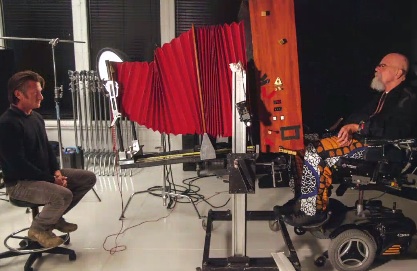
How Chuck Close deals with celebrity
At Vanity Fair, Chuck Close says he wants to humanize the stars. Finally. No longer must I click to Guess My Face Without Makeup or the mug shots at www.thesmokinggun.com for a full dose of celebrity humanity. It used to be I could rely on my daughter, Christin, to endear me to famous actors, back when she was a handler at New Line Cinema for many of these luminaries on their publicity tours. I’d hear about how Woody Harrelson kept reporters waiting just a bit in Florida because he wanted to swim up along the Gulf Coast to get from his hotel to where the reporters were meeting him. Seriously. He swam to his interviews. Energy efficient and good cardiovascular: so what reporter would complain about having to wait? If I’d been there with a voice recorder, I’d have felt ashamed for having driven to see him. She also told us how Chris Tucker carried his new MacBook around from one place to another on his tour, in the Apple box itself, with its plastic black handle, using it like a briefcase. When I heard that, I thought, why not? Who’s he need to impress? Tucker was humble enough to ask her for some quick tutorials to get him up to speed with his Mac interface after it arrived. I warmed up to most of them, when I heard how they acted when a camera was pointed at them. That seems to be what Close has in mind: to warm us up to all the ordinary-ness in their faces.
I’d love to borrow that Polaroid camera if only I wouldn’t have to build an addition over the garage for it. It would be funny if Close shook the huge photographs when they came out, just for old time’s sake.
February 25th, 2014 by dave dorsey
 There are many ways to be creative.
There are many ways to be creative.
February 23rd, 2014 by dave dorsey

Jeanette Winterson
“The so-called uselessness of art is a clue to its transforming power. Art is not part of the machine. Art asks us to think differently, see differently, hear differently, and ultimately to act differently, which is why art has moral force. Art asks that we remember who we are, and usually that asking has to come as provocation — which is why art breaks the rules and the taboos, and at the same time is a moral force. ” –Jeannette Winterson at Brain Pickings
February 21st, 2014 by dave dorsey
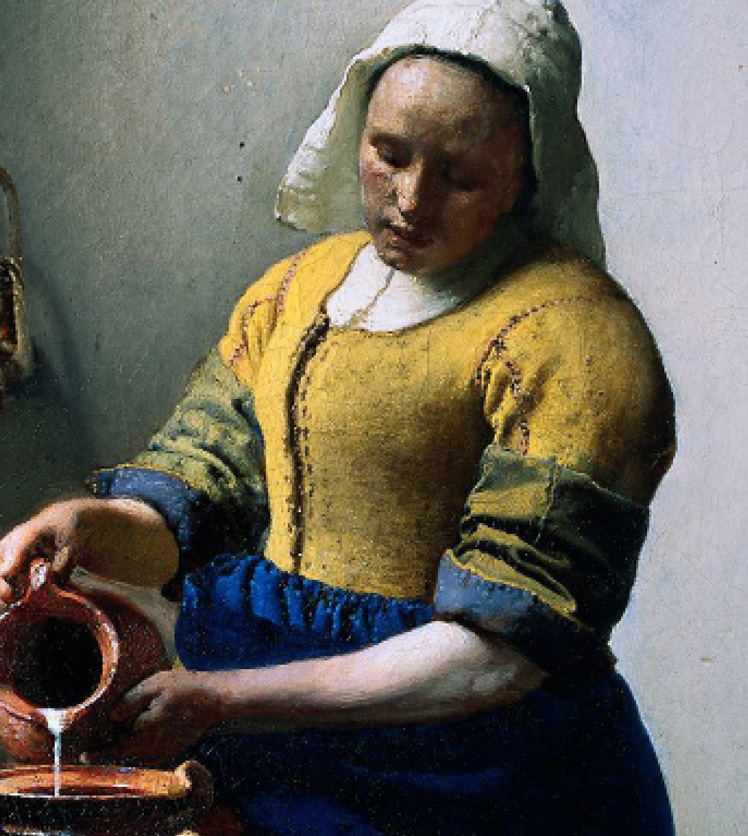
Vermeer’s Milkmaid, detail
Alain de Botton tweeted a link to this essay a few days ago, and it explores how reproductions are nearly as good as the original work. Clearly it was written by someone who doesn’t paint, but it’s the sort of thinking Warhol would have loved. I loved the assertion that we know what novels “are for.” What was Remembrance of Things Past “for”, exactly? It’s like asking what life is “for.” As I learned again recently at the National Academy Museum in Manhattan, seeing an actual Welliver (more like standing inside it) after seeing his paintings only in reproduction is like actually kissing someone after doing video calls with them for thirty years. You can learn nearly as much about who a person is from a distance, compared with being in the same room with him or her, if all you want is information and amusement. But contrary what the movie Her suggested, it just isn’t equal to what’s conveyed in a simple kiss. Original paintings are one of the few genuinely scarce things left in a world of generic information and freely exchanged music files: which themselves can be degraded copies of what used to be rich analog vinyl recordings.
Sorry, Internet. Deal with it.
February 19th, 2014 by dave dorsey
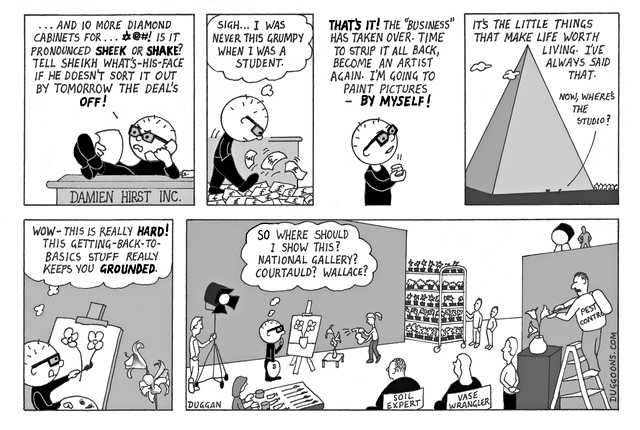
Damien Hirst at the drawing board
Damien Hirst keeping it real at The Guardian. Any openings for “vase wrangler?” I have experience.
February 17th, 2014 by dave dorsey
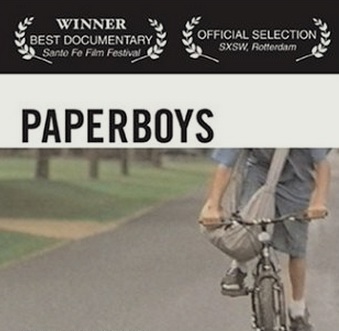
On my cousin Brian’s advice, I bought a used DVD of this documentary from Amazon for $10. I was a paperboy once, in Boise, and I remember the needle-nosed pliers I brought to the streetcorner where my manager dropped a bale of papers at 4 a.m. I used the pliers to snap the wires around the stack of Idaho Statesmans, folded them and stuffed them into my bag, the set off down Irving Street in the dark. I think I had maybe 60 subscribers on my route. The worst part was collecting for the month’s subscription, with my little perforated tablet of receipts, knocking on doors and having people hand me cash in exchange for a little ticket I ripped from the top sheet. No, wait, the worst part was when our manager tried to turn us into salesmen and drove us down into the valley knocking on doors in the less privileged neighborhoods, asking people to sign up for the newspaper. I really hated that. There was no Internet, of course; it was long before computers, back when I kept a collection of 45 rpm hit singles, with the big hole in the middle requiring the plastic adapter for the turntable spindle, songs like Red Rubber Ball and Black is Black and Sloop John B. But I digress . . .
The point is, this film is directed by a graphic designer who did “groundbreaking collaborative design for Beck, Beastie Boys and Sonic Youth.” It came out sixteen years ago or so, back in the heyday of the first (or was it second) bubble, better known then as the dot.com boom. Oh, those were the days, when the economy at least appeared to be strong. He says:
I wanted to see if these kids were aware that they are part of a long tradition. Were they aware of how they were also changing that tradition? While doing this film I was excited to see how the almost Norman Rockwell image of the paperboy blended in with the contemporary Eminem-influenced teenage boy. This hybrid of contemporary television/rap oriented teen and American icon of “the good old days” is so full of contradictions that happily live together.
Our Democrat and Chronicle, here in Pittsford, is delivered by an adult in a car, who comes around as early as my manager did in Idaho. He’s diligent and industrious. We pay by mail. I miss the kids on their bikes. It’s consolation that the Girl Scouts still knock gently on our door, offering to put our name on their list for cookies. Some traditions endure.
February 14th, 2014 by dave dorsey

Bill, on Artists in Berlin
Bill Murray to Charlie Rose on Berlin as an artists’ colony: “Berlin is a bubbling place. It’s an artists’ colony. Sort of like Austin, Texas. All the artists of Europe flock there because it’s relatively inexpensive. People live like socialists sort of; there are the squatters. I know an American guy, he was a socialist here, he went to Berlin and he rents his little place and squats somewhere else. I would think Berlin would be a wreck, but what they didn’t bomb is completely intact. On the East German side nothing is changed.”
It almost sounds as if parts of Berlin have been awaiting a renovation since WW II: where people can just squat and live for free. Hm, if it’s either Detroit or Berlin, is there really a choice?
February 11th, 2014 by dave dorsey
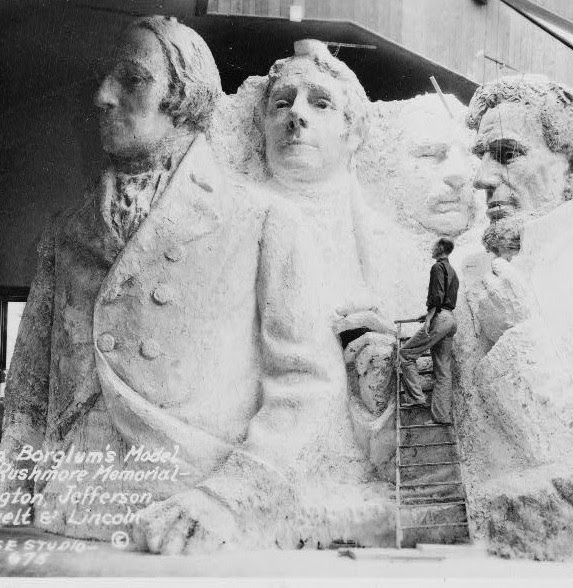
But they ran out of money.
February 9th, 2014 by dave dorsey
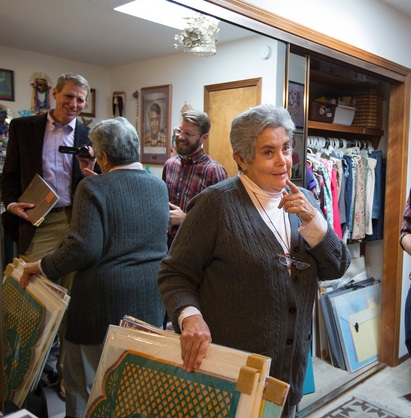
Catalina Delgado-Trunk, an undiscovered artist visited by Alice Walton’s scouts
If somebody knocks this year, answer the door. Alice Walton is sponsoring a search for unknown, unrepresented talent for a show meant to be her challenge to the Whitney Biennial and the art-world dominance of New York and Los Angeles. Her team ranks each prospective artist on three scales: engagement, virtuosity, and appeal. Refreshingly simple. Says the Times, “They are already logged 50,000 miles visiting 500 artists in 30 states, and they had almost 500 more to go.”
February 7th, 2014 by dave dorsey
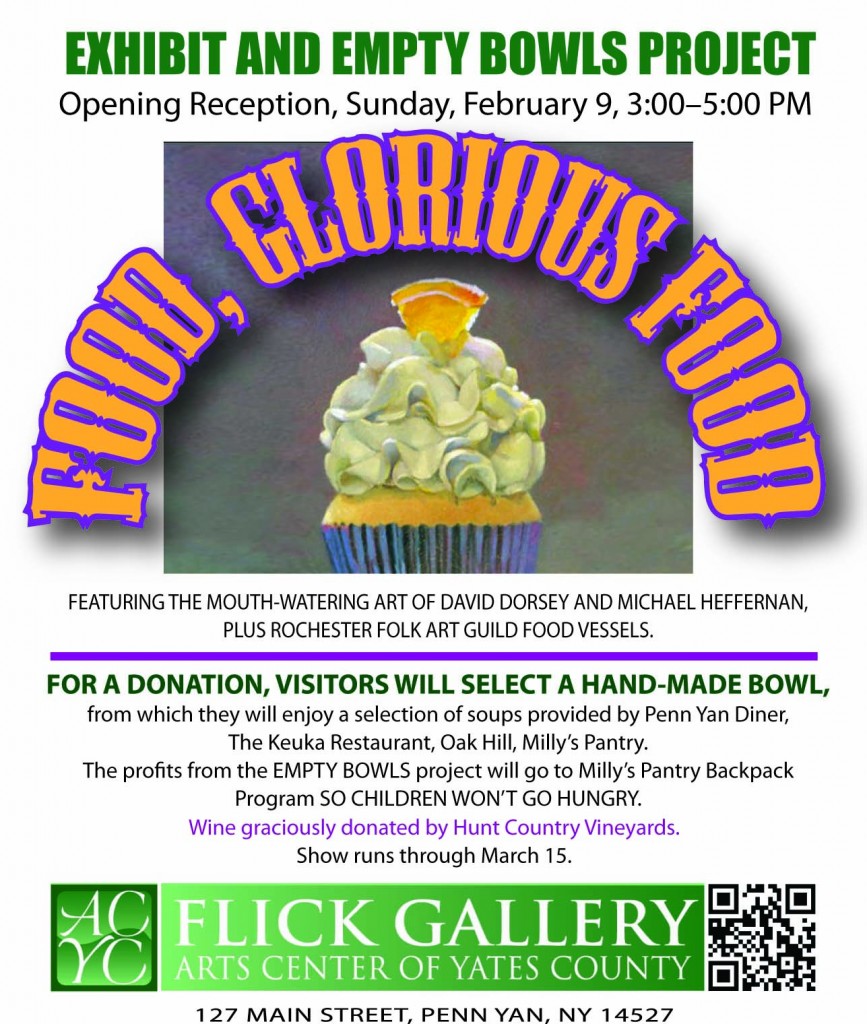
I’m donating 15 percent of any sales to the Empty Bowls project.
February 6th, 2014 by dave dorsey

Still Life with White Eggplant and Radicchio, Amy Weiskopf
“FOUNDED IN NEW YORK CITY in 1994, Zeuxis began as an association of painters exploring the possibilities of still life—traditionally the least prestigious of genres—in the post-Modernist art world.”
— Zeuxis
Fellow Oxford Gallery artist, Matt Klos, will be included in an exhibition at First Street Gallery of still life paintings around the theme of “blue.” He has a three-artist show coming up at Oxford next month as well.
From the email announcement: FIRST STREET GALLERY is pleased to present a group exhibition by Zeuxis, An Association of Still Life Painters.
“Painters compose with color the way composers paint with notes; one form builds in space, the other in time… And here is something else music and painting have in common: both can sing the blues.”
Any self-respecting still life, of course, is never still in the sense of being static. Its colors shift, push and build: a blue can be icy or mild, bracing or elusive. The challenge set by Zeuxis for the artists in Still, Blue is to investigate a particular blue, and from its character develop an entire painting.
Since 1995 Zeuxis, an association of still life painters, has organized dozens of group shows in New York City and around the country. Its exhibitions have been reviewed by The New York Times, The New York Sun, The Hudson Review, The Philadelphia Inquirer, and many other publications. The 31 participants in “Still, Blue” include, in addition to the artists of Zeuxis, guests Sallie Benton, Matt Klos, Carol Stewart, Benny Fountain, Catherine Maize, Stephanie Rauschenbusch, and Sheldon Tapley.
February 5th, 2014 by dave dorsey

Surfacing Watermelon, Shoji Miyamoto, Japanese woodblock
A fantastic show of work from 13 contemporary Japanese artists, at the Memorial Art Gallery, stuck me as a thrilling demonstration of how an obsessive focus on something as impersonal as method can generate original, idiosyncratic work that’s emotionally powerful and wonderfully expressive. I’ve been working on work for a small solo show in June at Viridian Artists, built loosely and maybe a bit whimsically around the idea of polarity, so I was primed to be dazzled by what I saw here. All the work here levitates in the mind, lofted by the magnetic poles of opposing forces: the abstract work hints beautifully at representation and the most representational work hews faithfully to narrow formal constraints. The rigor of technique disciplines, unobstreperously and almost politely, intense personal passions: you can feel the Japanese adherence to self-effacement in the strictures these artists have applied to what they do, and yet, at the same time, these self-imposed boundaries seem to heighten the passion. It’s like watching The Age of Innocence, start to finish, in a single glance. What you end up with is highly refined mastery, and remarkably some of these artists appear to be only a few years into their careers.
Curated by Sam Yates, of the Ewing Gallery of Art and Architecture, with a MORE
February 3rd, 2014 by dave dorsey

The third floor of Rod Stewart’s Los Angeles home contains a model railroad layout that measures 23 X 124 feet, and he estimates that he has at least another three years before it’s complete. Is it a work of art? In the Daily Beast, Malcolm Jones thoughtfully suggests that maybe it is. In a world where a diorama counts as art, why not? It’s a miniature representation of some part of the world, in three dimensions, after all. There’s a passage in the piece that makes me want to agree:
I laughed when saw the story. And then I began reading about the depth and breadth of his zeal (he has two assistants, he rents an extra hotel room on the road when he’s performing for designing, building, and painting the structures that populate his layout). Then I studied the photographs in the magazine closer—and the more I looked, the more impressed I became. The attention to detail, coupled with carpentry skills and a painter’s eye (he’s colorblind and someone has to check his reds and greens, but still), strongly suggest that here is an artist—a nutty artist, maybe, but an artist.
February 1st, 2014 by dave dorsey
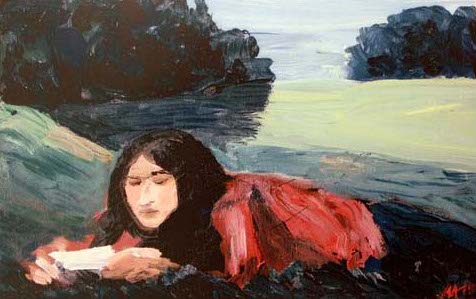
The Letter, Henry Coupe, oil on linen, 10×16
Henry Coupe, one of the most recent new members at Viridian Artists, has finished his career as an artist, but I hope his reputation has only begun to gain momentum. All his life, he struggled with various degrees of vision impairment, and yet he lived for painting. He deserves a lot more attention than he got while he was actually creating art, and if I had the money to be a collector I’d be grabbing a room full of his canvases right now. His work, mostly very small, does exactly what much of my favorite painting invariably does: it calls my attention to the quality of the paint itself, purely as paint, while it evokes something that takes me away from the medium and into a dream. That polar struggle between the physical reality of a canvas and what it fools you into seeing is at the heart of why painting matters, for me–and Coupe also has a sense of color that’s both somberly beautiful, but somehow also conveys solitude, isolation and yearning. He studied in Utica with a student of Hans Hofmann, where he grew up and lived all his life, and his work shows not just his love of expressionists like Kirchner, but, like Hofmann, a strong sense for simplifying areas of pure color, composed with an eye to the abstract pattern he assembles on the surface. His sense for color is akin to what Louisa Matthiasdottir–who studied directly with Hofmann–achieved in her brilliantly simplified scenes of Iceland, which are as colorfully intense as a Hodgkins canvas. Coupe’s color can be just as evocative as hers, but in ways it’s more elusive and mournful, submerged in an aura of darkness from which his figures always struggle to emerge.
I stopped in Utica to meet his wife, Ann, a while ago and spent the MORE













